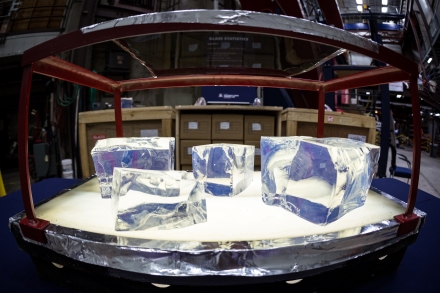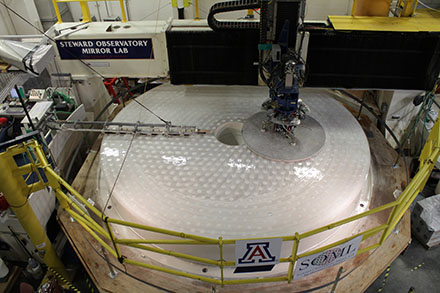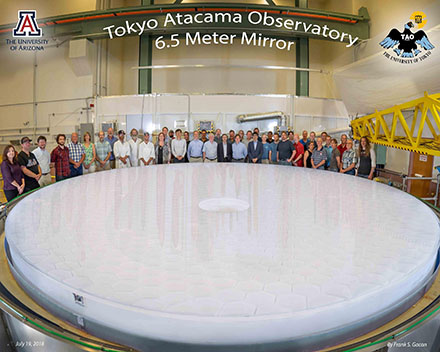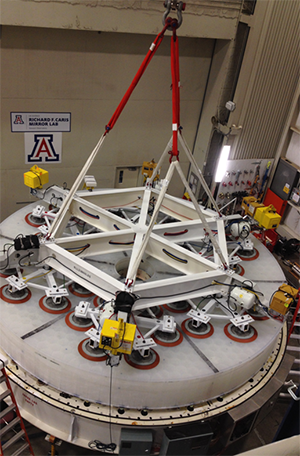
|
TAO Project |
|
The TAO project

|
Optical performance test of the 6.5-m primary mirror has been completedThe large primary mirror of the TAO telescope, which collects the light from celestial objects, started production in September 2013 (*the contract date). It was manufactured by the Mirror Laboratory of the University of Arizona (the current official name is Richard F. Caris Mirror Laboratory), which has manufactured many primary mirrors of large optical-infrared telescopes (Final Polish of the 6.5m Primary Mirror Has Started !). The primary mirror is in the form of a concave hyperbolic with a diameter of 6.5 m, whose size is the same as those of MMT (USA), Magellan Telescope (Chile), and Lockheed Martin Telescope (USA), also manufactured by the Mirror Lab. This is the largest primary mirror among those of the optical-infrared telescopes operated by universities in Japan. The primary mirror of the TAO telescope is made of borosilicate glass (Fig.1), which is provided by OHARA Inc. in Japan. First, the honeycomb-structured primary mirror is cast by a large amount of glass melted at high heat in an oven. Second, the back surface then the front surface are polished with lots of care and time (Fig. 2). The honeycomb structure, which is similar to the hexagonal prismatic cells in honey-bees nests, has the advantages of high rigidity and lightweight at the same time. This structure is also suitable for suppressing air turbulence in front of the mirror surface to obtain sharp stellar images by keeping the mirror temperature close to the atmospheric temperature, which changes in time during observation.
After completion of the primary mirror polishing, the error of the surface figure of the primary mirror mounted on the support system was measured at only 27.4 nanometers (1 nanometer is 0.000001 millimeter). This demonstrates the good optical performance of the primary mirror, which enables us to obtain sharp astronomical images without compromising the excellent observing conditions at the summit of Co. Chajnantor. The production of the primary mirror was successfully completed (Fig.3).
Since the primary mirror is very heavy, gravitational force distorts the mirror surface figure when the mirror tilted on the telescope. This distortion is compensated by the support system of the primary mirror in order to observe celestial objects in all directions of the sky. The correction is done by adjusting the support forces of the pneumatic actuators attached on the back side of the primary mirror, which is controlled by the telescope control computers. In this way, the primary mirror becomes able to act as a mirror correctly in all directions, from zenith to horizon. The remaining two mirrors that make up the telescope optics, the secondary and the tertiary mirrors, are similarly supported by pneumatic actuators to keep the mirror surface figures correctly. The TAO telescope functions properly as a “telescope” by controlling all three mirrors. All systems for adjusting the support forces of the pneumatic actuators and the temperature of the primary mirror are controlled by a dedicated computer. After the completion of the development of each individual software for the dedicated computer, the connection test with the telescope control computer was conducted at the University of Arizona in January 2020 with LLP Kyoto Niji-Koubou to examine the communication and to make sure the mirror control functions work properly in response to the control commands. Since the unit tests had been completed, this test was intended to verify that the total system works properly. In this total system test, not only the functions to control the force distribution and the mirror temperature but also the safety procedures and the emergency stop were verified assuming various situations. The mirror control system is ready for the final function test after the integration at the summit. The primary mirror is stored at and managed by the University of Arizona in a dedicated transport box to be ready for sea and land transportation to the summit of Co. Chajnantor, Chile (as of July 1, 2020). The primary mirror cell, which is mounted on the telescope with the primary mirror being integrated inside, the dedicated transport box for safe transportation, and the mirror lifting fixture (Fig. 4) to pick off the primary mirror from the transport box and install it into the primary mirror cell were also designed and fabricated by the University of Arizona, and are ready for transportation. After the primary mirror is transported to the summit, the mirror surface will be coated with aluminum using a dedicated coating chamber, then integrated into the telescope to catch the light from the Universe at the world’s highest site on earth.
Copyright(c) 2022 TAO Project, Institute of Astronomy, Graduate School of Science, University of Tokyo
|



